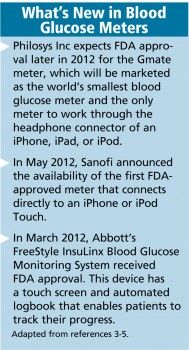Publication
Article
Pharmacy Times
Blood Glucose Meter Essentials
Author(s):
The right meter can put patients on the path to proper diabetes management.
The right meter can put patients on the path to proper diabetes management.
Maintaining tight glycemic control is critical to successfully managing diabetes and reducing or preventing potential complications associated with the condition.
Toward this end, a reliable blood glucose meter is an essential tool for all diabetes patients. It allows one to track glucose patterns, meet daily glucose targets, detect hyperglycemia or hypoglycemia, and monitor one’s glycemic response to foods, medications, physical activity, or therapy changes.1
Features Abound
A wide range of self-testing blood glucose meters are available to meet the needs of all diabetes patients, including children. Technological advances have enabled manufacturers to make meters that are less invasive and less painful during testing, require a smaller blood sample size, offer the option of alternate-site testing, provide rapid testing results, and are capable of testing without interrupting one’s daily routine. Some meters have large memory storage, some have audio capability, and some can measure blood pressure or ketones in addition to blood glucose levels.
Choosing the Right Meter
Selecting an appropriate meter may be overwhelming for some patients, especially because new products are constantly entering the market. Pharmacists can be instrumental in helping patients to select a meter that will help them monitor their blood glucose levels while remaining compliant with their diabetes therapy plan.
Features that may be considered when selecting a meter include accuracy of test results, meter size, required blood sample size, ease of use, options for alternate testing sites, time before results are available, portability, display readability, amount of memory, and cost.1,2

Ensure Proper Use
Once a patient selects a blood glucose meter that suits his or her individual needs, the patient must be comfortable using the meter and understand the proper testing procedure to obtain accurate and reliable results (Table).

It is critical that pharmacists stress the importance of adhering to the patient’s recommended treatment plan, remaining compliant with prescribed medications, monitoring blood glucose regularly, and maintaining a healthy, balanced diet and exercise routine. Patients should also be encouraged to discuss their blood glucose meter results with their primary health care provider.
Ms. Terrie is a clinical pharmacy writer based in Haymarket, Virginia.
References:
1. Ulbrich T, Krinsky D. Self care components of selected chronic disorders. In: Krinsky D, Berardi R, Ferreri S, et al, eds. Handbook of Nonprescription Drugs. 17th ed. Washington, DC: American Pharmacists Association; 2012.
2. Checking your blood glucose. American Diabetes Association website. www.diabetes.org/living-with-diabetes/treatment-and-care/blood-glucose-control/checking-your-blood-glucose.html. Accessed August 25, 2012.
3. Sanofi iBGStar blood glucose monitoring system now available in the U.S. Sanofi diabetes website. www.multivu.com/mnr/46108-sanofi-ibgstar-blood-glucose-monitoring-system. Accessed August 27, 2012.
4. Abbott’s new Free Style Insulinx Blood Glucose Monitoring System receives FDA clearance. Abbott Diabetes Care website. www.abbott.com/news-media/press-releases/abbotts-new-freestyle-insulinx-blood-glucose-monitoring-system-receives-fda-clearance.htm. Accessed August 27, 2012.
5. Blood glucose meters. American Diabetes Association website. www.diabetes.org/living-with-diabetes/treatment-and-care/blood-glucose-control/blood-glucose-meters.html. Accessed August 25, 2012.
6. Philosys, Inc. anticipates U.S. FDA approval for new Gmate Blood Glucose Monitoring System. www.gmate.com/announce.asp. Accessed August 27, 2012.
7. Blood glucose meters. American Diabetes Association 2012 Consumer Guide. http://forecast.diabetes.org/files/images/v65n01_BG_Meters_0.pdf. Accessed August 25, 2012.







